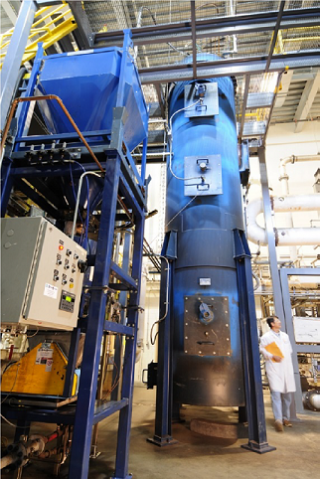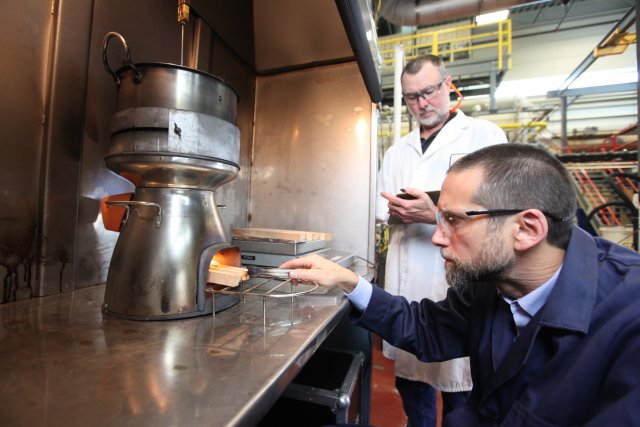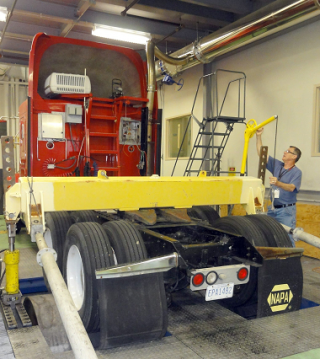Characterization and Mitigation of Combustion Sources Research

EPA is conducting research to characterize the physical and chemical properties of air pollutants emitted from combustion sources to provide support for air quality regulation and policy determinations and to understand the effect of combustion emissions on public health and environmental welfare. The work covers a wide variety of combustion emissions sources including the transportation sector, commercial and industrial sectors, and household and domestic energy sectors.
On this page:
- Particulate Matter and VOC Characterization of Combustion Emissions
- Condensable Particulate Matter Characterization and Methods Development
- Household Energy and Clean Cookstoves
- Mobile Sources of Air Pollution
Particulate Matter and VOC Characterization of Combustion Emissions
Novel emissions characterization research on a wide variety of anthropogenic combustion sources is helping advance the understanding of air pollution exposure risks and improve air quality and public health outcomes. Emissions from commercial and industrial scale operations, oil and gas facilities, refineries, mobile sources (including on- and off-road vehicles) wildland fires, and residential wood combustion require specialized sampling and measurement methods. EPA works to develop, evaluate and apply new analytical and chemical measurement methods for these source emissions.
These analytical-chemical technologies and methods enable more accurate measurement of toxic metal and carbonaceous pollutant concentrations in the gas- and particle-phases. Source and near-source measurement technologies evolve rapidly. EPA researchers strategically design studies to take advantage of emerging technology and apply it to high-priority source emissions sectors for environmental pollutants of public health concern. A diverse array of emissions measurement methods is applied to improve and support global emissions inventories and community-based air quality models, and to develop, implement and enforce the National Ambient Air Quality Standards (NAAQS).
Both laboratory and collaborative field studies are used to accomplish these research objectives. Recent research projects include:
- Quantitative determination of hazardous air pollutants and ethylene oxide from mobile emissions.
- Development and verification of volatility profiles for particulate matter (PM) and organic aerosol emissions using gas chromatography-mass spectrometry.
- Use of Fourier Transform Infrared Spectroscopy (FT-IR) for chemical functional group determination in complex PM mixtures.
- Application of GC-MS methodology for determination of light PFAS compounds in emissions.
Condensable Particulate Matter Characterization and Methods Development
Researchers are investigating the formation of condensable particulate matter (CPM) by comparing existing methods and conducting measurements in a pilot-scale combustion research facility. Condensable particulate matter is vapor that occurs in smokestacks of stationary combustion facilities such as power plants. The vapor condenses or reacts when cooled and dilutes in the ambient air to form solid or liquid particulate matter (PM) immediately after discharge from the stack. A major component of CPM is fine particulate matter (PM2.5), which is harmful to health and regulated under the National Ambient Air Quality Standards (NAAQS).
Research is focused on developing a better method for measuring CPM and understanding CPM formation conditions and rates during the combustion process. Studies have shown inconsistent results with the use of Method 202, which EPA promulgated in 1991 for use by state and local air pollution control agencies to measure CPM emissions from stationary sources. State and local air pollution control agencies use the measurements to include the full range of PM emissions from smokestacks. EPA developed a best practices handbook that minimizes potential bias.
CPM speciation using aerosol mass spectrometry is being conducted to develop a better method and improve characterization. Researchers are conducting tests to compare Method 202, which is an “in-stack” method that has been approved as a federal reference method, to another dilution-type method called Other Test Method 37 (OTM-37). This provisional method has not been subject to the federal rulemaking process; however, it has been found to be potentially useful for measuring primary PM.
The research is conducted at EPA’s Multi-Pollutant Control Research Facility (MPCRF) in Research Triangle Park, North Carolina. The MPCRF combustor is a pulverized coal-, natural gas- and biomass-fired furnace. At its pilot-scale size, emissions control technologies may be tested, modeled, and scaled-up to provide results for use by regulatory and commercial/industrial partners.
Related Links
- EPA (2016) Method 202 Best Practices Handbook, U.S. Environmental Protection Agency
- EPA (2017) Method 202 Dry Impinger Method for Determining Condensible Particle Emissions from Stationary Sources, U.S. Environmental Protection Agency.
- EPA (2018) Other Test Method 37(OTM-37): Measurement of Direct PM2.5 and PM10 Emissions at Low Concentrations by Dilution Sampling (Constant Sampling Rate Procedure), U.S. Environmental Protection Agency
Household Energy and Clean Cookstoves

Nearly three billion people depend on the combustion of solid fuels for household energy needs. According to the World Health Organization, household air pollution from inefficient cooking practices using open fires or rudimentary stoves causes three to four million premature deaths and a wide range of illnesses annually. In the U.S., approximately a half million people, mostly in low-income areas, are directly affected by household air pollution from the burning of solid fuels. Worldwide emissions contribute to increases in air pollutants that circulate the globe.
EPA has partnered with the Clean Cooking Alliance, other U.S. government agencies, university researchers, and many international partners to conduct research to better understand potential benefits of interventions, develop international standards for cookstoves, evaluate the performance of cookstoves to encourage the development of sustainable technologies, and improve understanding of the impacts to public health and the environment, among other objectives.
Related Links
Mobile Sources of Air Pollution

Emissions from cars, trucks, buses, trains and other mobile sources are a major contributor to air pollution. Research shows that public health risks from transportation sources are higher in urban areas and areas near sources of transportation. They have been found to have a greater impact on lower-income communities, often located near major transportation infrastructure.
Scientists and engineers are conducting comprehensive research on transportation’s impact on air quality and human health. This research generates emissions data that include criteria pollutants, air toxics and detailed speciation of emissions.
At the Transportation Mobile Source lab in Research Triangle Park, North Carolina, the research team uses dynamometers, on-board portable emissions measurement systems (PEMS) and on-road chase vehicles to characterize emissions from transportation sources. On-road air sampling, mobile monitoring in the vicinity of transportation facilities, and fixed-site air quality samplers using regulatory monitors and sensors are employed to characterize how these sources impact air quality locally and regionally. Sensors are used to compare air quality impacts and actual exposures to air pollution experienced by workers and the general population in their daily activities.
The team collaborates with air dispersion modelers and health scientists to model these impacts and better understand how transportation emissions affect human health.
